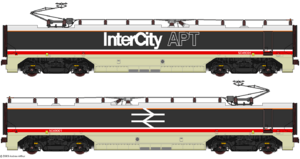British Rail Class 370 facts for kids
Quick facts for kids British Rail Class 370"Advanced Passenger Train" |
|
|---|---|
| In service | 1980-1986 |
| Manufacturer | BREL |
| Family name | APT |
| Number built | 3 trainsets |
| Formation | 14 cars per trainset |
| Operator(s) | InterCity |
| Line(s) served | West Coast Main Line |
| Specifications | |
| Height | 3.5 m |
| Maximum speed | 155mph (249 km/h) (Design) 125mph (200 km/h) (service) |
| Weight | 434 t |
| Electric system(s) | 25 kV AC Overhead |
The British Rail Class 370 trains, often called APT-P (meaning Advanced Passenger Train Prototype), were special high-speed trains. They were built as test versions of the Advanced Passenger Train project. These trains were different from earlier experimental models because they used electricity from overhead lines.
The APT-P trains ran on the West Coast Main Line. This busy railway line connects London Euston to Glasgow Central. The APT-P was the most powerful passenger train ever used in Britain. It had eight powerful motors that produced a huge 8,000 horsepower! This power helped the train set a new UK rail speed record of 162.2 miles per hour in December 1979. This record lasted for 23 years.
Contents
What Was the Advanced Passenger Train?
The Advanced Passenger Train (APT) was a project by British Rail to create a new generation of high-speed trains. The goal was to make trains that could go much faster on existing railway lines. This was important because building brand new, straight tracks for very high speeds is expensive.
How Did the APT-P Work?
The APT-P trains had a special feature called "tilting" technology. Imagine a motorbike leaning into a bend. The APT-P trains could do something similar! When the train went around a curve, its body would automatically tilt. This tilting helped passengers feel more comfortable and allowed the train to go faster through bends without slowing down.
Tilting Technology Explained
The tilting system used computers and hydraulic cylinders (like powerful arms that push and pull). Sensors on the train would detect when it was entering a curve. The computer would then tell the hydraulic system to tilt the train's carriages. This kept the passengers upright and prevented them from being pushed to the side, even at high speeds.
Power and Speed
The APT-P was an electric train. It got its power from 25,000-volt alternating current (AC) electricity supplied by overhead lines. This is a common way to power modern electric trains.
The train had two special "Motor Cars" in the middle of its 14-car formation. These Motor Cars contained the powerful engines. Each Motor Car had four traction motors, making a total of eight motors for the whole train. This massive power output of 8,000 horsepower made the APT-P incredibly fast. While it was designed to reach 155 mph (249 km/h), its service speed was 125 mph (200 km/h).
Life of the APT-P
Three APT-P trainsets were built. They started service in 1980. These trains were a big step forward in train design. However, they also faced some challenges.
Challenges and Legacy
Despite its advanced technology and impressive speed, the APT-P project faced some issues. There were technical problems and difficulties with public perception. Because of these challenges, the APT-P trains were only in service for a short time, from 1980 to 1986.
Even though the APT-P didn't stay in service for long, its technology was very important. The tilting system and other ideas from the APT project were later used in other successful high-speed trains around the world. For example, the tilting technology developed for the APT-P helped create the Pendolino trains, which are still used on the West Coast Main Line today. The APT-P showed what was possible and paved the way for future high-speed rail travel in Britain.


